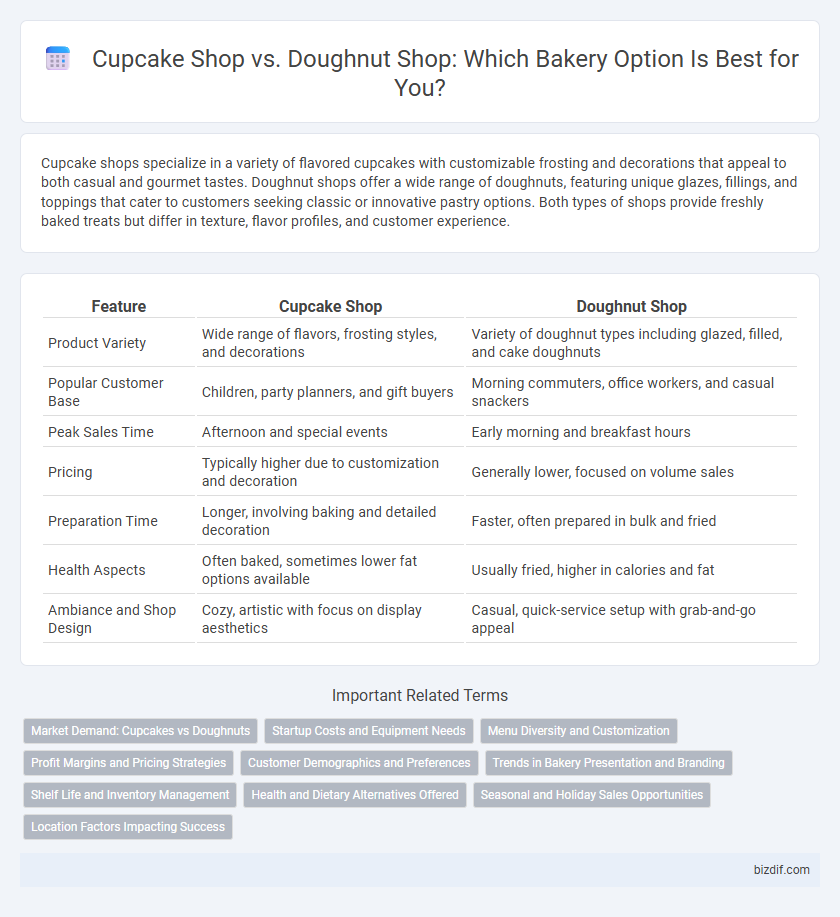Cupcake shops specialize in a variety of flavored cupcakes with customizable frosting and decorations that appeal to both casual and gourmet tastes. Doughnut shops offer a wide range of doughnuts, featuring unique glazes, fillings, and toppings that cater to customers seeking classic or innovative pastry options. Both types of shops provide freshly baked treats but differ in texture, flavor profiles, and customer experience.
Table of Comparison
| Feature | Cupcake Shop | Doughnut Shop |
|---|---|---|
| Product Variety | Wide range of flavors, frosting styles, and decorations | Variety of doughnut types including glazed, filled, and cake doughnuts |
| Popular Customer Base | Children, party planners, and gift buyers | Morning commuters, office workers, and casual snackers |
| Peak Sales Time | Afternoon and special events | Early morning and breakfast hours |
| Pricing | Typically higher due to customization and decoration | Generally lower, focused on volume sales |
| Preparation Time | Longer, involving baking and detailed decoration | Faster, often prepared in bulk and fried |
| Health Aspects | Often baked, sometimes lower fat options available | Usually fried, higher in calories and fat |
| Ambiance and Shop Design | Cozy, artistic with focus on display aesthetics | Casual, quick-service setup with grab-and-go appeal |
Market Demand: Cupcakes vs Doughnuts
Market demand for cupcakes has surged due to their customizable flavors and premium presentation, making them popular for events and gifting, while doughnuts maintain steady demand driven by traditional appeal and convenience. Cupcake shops often target niche markets with innovative recipes and dietary options, whereas doughnut shops rely on mass appeal and breakfast routines. Sales data indicates cupcakes generate higher revenue per item, but doughnuts achieve greater overall volume in fast-service environments.
Startup Costs and Equipment Needs
Starting a cupcake shop typically requires higher initial investment in specialized baking ovens, decorating tools, and display cases compared to a doughnut shop, which primarily needs fryers and proofing cabinets. Cupcake shops often spend more on ingredients like high-quality frostings and flavorings, while doughnut shops focus on bulk raw materials such as flour and oils. Equipment costs for doughnut shops tend to be lower due to simpler production processes and less demand for intricate decoration tools.
Menu Diversity and Customization
Cupcake shops often offer a wide range of flavors, frostings, and toppings, allowing customers to customize their orders extensively, including size and decorative themes. Doughnut shops typically focus on classic and seasonal varieties but may provide fewer options for personalized designs or ingredient substitutions. Menu diversity in cupcake shops tends to be broader, catering to specific dietary preferences such as gluten-free or vegan options more frequently than doughnut shops.
Profit Margins and Pricing Strategies
Cupcake shops often achieve higher profit margins through premium pricing, capitalizing on customizable designs and specialty flavors that attract niche markets. Doughnut shops typically rely on volume sales with lower price points, leveraging bulk orders and daily traffic to sustain steady revenue streams. Strategic pricing in cupcake shops emphasizes exclusivity and freshness, while doughnut shops prioritize affordability and frequent purchases to maximize profitability.
Customer Demographics and Preferences
Cupcake shops typically attract younger customers and event planners who favor customizable, visually appealing treats for celebrations. Doughnut shops often draw in a broader demographic, including commuters and office workers seeking quick, affordable breakfast options with classic flavors. Understanding these distinct customer preferences helps bakery owners tailor marketing strategies and product offerings to maximize engagement and sales.
Trends in Bakery Presentation and Branding
Cupcake shops emphasize vibrant, customizable designs and Instagram-worthy packaging to appeal to social media-savvy customers, driving brand engagement through visual storytelling. Doughnut shops leverage artisanal glazing techniques and unique flavor combinations, often incorporating local ingredients to create a distinctive regional identity. Both bakery types utilize minimalist logos and eco-friendly packaging as trending strategies to enhance brand authenticity and sustainability appeal.
Shelf Life and Inventory Management
Cupcake shops typically experience shorter shelf life challenges due to the high moisture content and delicate frosting, requiring more frequent restocking and precise inventory management to minimize waste. Doughnut shops benefit from slightly longer shelf life, especially with yeast-based varieties, enabling more flexible inventory turnover and reduced spoilage risk. Efficient inventory management in both settings hinges on understanding product perishability and optimizing baking schedules to align with peak freshness demands.
Health and Dietary Alternatives Offered
Cupcake shops often provide a variety of health-conscious options such as gluten-free, vegan, and low-sugar cupcakes made with alternative flours and natural sweeteners. Doughnut shops increasingly offer baked doughnuts and options made with whole-grain flours, plant-based ingredients, and reduced-fat recipes to cater to dietary restrictions. Both bakery types prioritize allergen-friendly and keto-friendly products to meet diverse consumer health demands.
Seasonal and Holiday Sales Opportunities
Cupcake shops capitalize on seasonal and holiday sales by offering themed flavors and decorative designs tailored to occasions like Valentine's Day, Halloween, and Christmas. Doughnut shops boost revenue during these periods by introducing limited-edition toppings and festive packaging that attract gift buyers and event hosts. Both businesses increase foot traffic and sales through targeted promotions aligned with holiday trends and seasonal preferences.
Location Factors Impacting Success
Cupcake shops thrive in high-foot-traffic urban areas where impulse purchases and specialty treats are in demand, benefiting from close proximity to offices, schools, and shopping centers. Doughnut shops perform best near transit hubs and residential neighborhoods, attracting early morning customers seeking quick, convenient breakfast options. Both require visibility and accessibility, but demographic preferences and peak buying times significantly influence their strategic location choices.
Cupcake shop vs Doughnut shop Infographic

 bizdif.com
bizdif.com